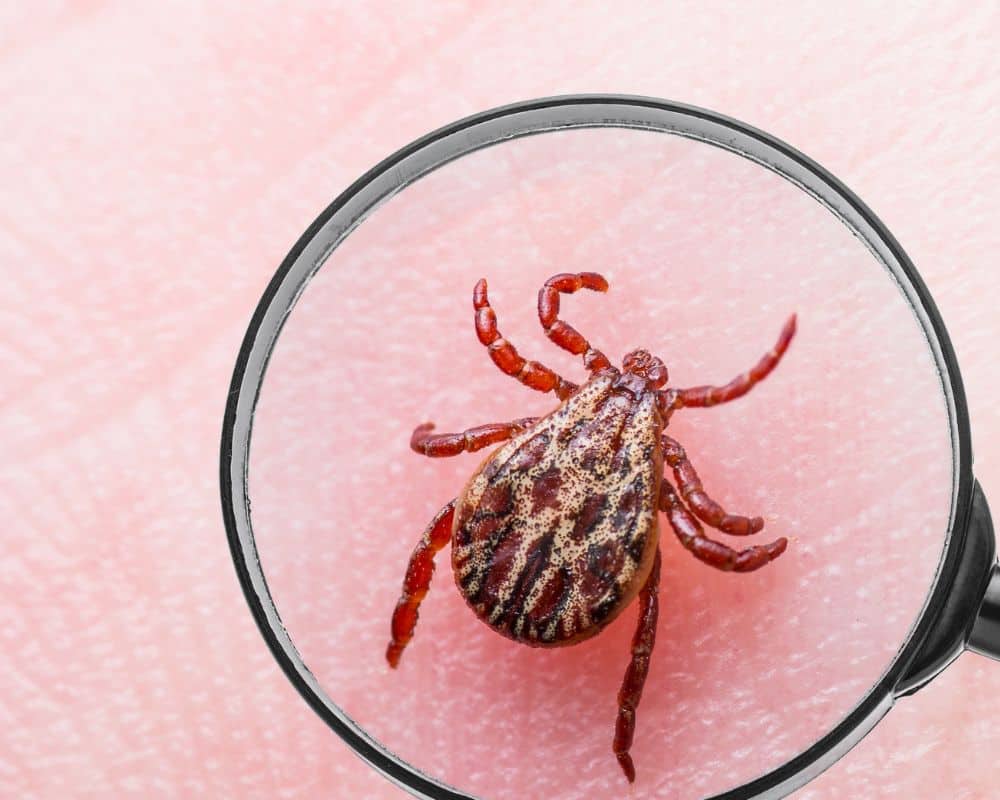I think every mother knows that feeling of panic when you see a tick embedded somewhere on your child. AHHHH! And some advice says that you should do a round of preventative antibiotic therapy after finding a tick to help avoid the risk of tick-borne illness.
Look, my kids are outside all summer long. If we administered antibiotics for every tick, we’d take dozens of rounds of antibiotics before the close of tick season. The standard treatment just doesn’t make sense for us, but I’m so thankful homeopathic medicine can address tick bites, too! Keep reading for my full tick plan because being prepared is always better than being panicked!
But Shouldn’t Tick Bites Be Taken Seriously?
Yes, tick bites should be taken seriously! Some of the most common problems from tick bites include chronic Lyme disease, Alpha-Gal Syndrome, and Rocky Mountain Spotted Fever. I don’t want to pretend like these diseases aren’t a big deal. We all know people suffering from them. In fact, the CDC reported 63,000 cases of diagnosed Lyme Disease in 2022 (source).
But I want to stop and make 2 points before we go any further.
1) Treating illnesses homeopathically IS ONE WAY to take them seriously. In fact, it’s taking your OVERALL health seriously.
2) Just because there was an attached tick DOES NOT mean the person will get Lyme disease or a disease of any kind.
What is Lyme Disease?

According to the CDC, “Lyme disease is the most common vector-borne disease [meaning from a parasite] in the United States. Lyme disease is caused by the bacterium Borrelia burgdorferi […]. It is transmitted to humans through the bite of an infected blacklegged tick. Typical symptoms include fever, headache, fatigue, and a characteristic skin rash called erythema migrans [bulls-eye rash].” Some people also suffer from muscle aches, abdominal pain, trouble sleeping, loss of appetite, sore throat, flu-like symptoms and more.
Sounds awful, right? It’s no wonder that a tick bite will send many people running for standard antibiotic treatment. But, again, what if you spend lots of time outdoors and find a tick on somebody nearly every day? Then what? Should we take round after round of antibiotics? Since antibiotic offer no guaranteed protection against Lyme, and since they wreak havoc and your overall health, for my family, I say no. If you aren’t aware of how antibiotics can wreak havoc on your health, I’ll drop some studies here for you to explore.
- Study: Impact of antibiotics on the human microbiome and consequences for host health
- Study: Antibiotics and mental health: The good, the bad and the ugly
- Study: Association of Adverse Events With Antibiotic Use in Hospitalized Patients
- Study: Association of Adverse Drug Events with Broad-spectrum Antibiotic Use in Hospitalized Patients: A Single-center Study
- Study: Antibiotic exposure and adverse long-term health outcomes in children: A systematic review and meta-analysis
- Study: Association of Infant Antibiotic Exposure With Childhood Health Outcomes
Can We Do Anything to Prevent Lyme Disease?
Dr. Josh Axe makes some great points about Lyme Disease. He explains, “It’s important to understand that although Lyme disease originates from a tick bite, symptoms arise due to an inflammatory process. Two people who are both bitten by the same tick carrying the bacteria that causes Lyme disease can respond very differently. That’s why preventing and treating Lyme disease symptoms by maintaining healthy immune regulation is key.” (source)
Our immune response plays a huge role in how our bodies respond to assaults of all kinds, including a tick bite. That’s why building up our immune system is so important. If you aren’t already, do all you can to make sure that your child is eating a healthy, real food diet. If you’ve got a picky eater, time to work on that! This article can help. Be sure you are including superfoods like homemade bone broth and raw milk, too. These nutrition powerhouses can help you cover a lot of ground quickly when it comes to strengthening the immune system.
There are also some first-aid steps you can take after finding a tick that can help reduce the risk of Lyme and other infectious disease associated with tick bites. Let’s dive into those.
Our Step-By-Step Plan for When We Find a Tick
(Before I begin, let me remind you that I’m not a medical professional, and this isn’t medical advice. I’m just a crunchy mama who has done her homework! I’m sharing how I choose to address the tick issue with my family. This article is not meant to diagnose, treat, or cure anything. Use your own discretion and seek professional medical help if needed.)
Print this 4 x 6 index card from the Freebies Library! Perfect for your first-aid kit.
1. Remove Tick– Found a tick? First things first…remove it! We simply use tweezers to gently pull it out. The goal is to remove the head with the tick, so we grab at the very base of the tick (neck area, not tail area) and pull with slow, steady force. Some people also choose to invest in a tick removal device like this one that attaches to your key ring.
Here is more info on tick removal from the CDC. I should point out that the CDC’s advice stops here. They say remove the tick, then if you see a rash or fever in the following weeks, contact your doctor. As a pro-active mom, I know there is much more I can do to help prevent complications.
2. Save Tick– It’s always a good idea to save the tick. Just put it in a freezer-safe plastic bag, label it with the person’s name, date found, and location of bite (Example: Eliza, 7/15/23, inner right arm just above elbow). I’d try to keep the tick for about a year, then toss it. If need be, it could be sent to a tick testing lab. And, should prolonged problems arise, some homeopaths suggest having a customized homeopathic remedy made from the exact tick that gave the harmful bite. They’re easy enough to save, so no reason not to hang on to it.
3. Clean Bite Site- Now we clean the bite site. We use some Colloidal Silver like this one. Cover the area liberally with silver and let it sit for 2-3 minutes. Then wipe the area with a clean cloth. There are many studies that show collodial silver’s ability to kill a variety of bacteria. And the National Institutes of Health has even found that it successfully kills the bacteria responsible for causing Lyme (source).
4. Give First Dose of Ledum 200- Homeopathic Ledum Palustre 200 is the top recommendation for most insect bites, especially ticks. It’s great for puncture wounds of all kinds, but when used after a new tick bite, most homeopaths agree that Ledum can keep problems at bay. In this case, I’d give 2 pellets by mouth. The pellets are tiny and dissolve quickly, so I give them to even my youngest babies as needed. You can read more from professional homeopaths that recommend Ledum for bites and Lyme prevention here and here.

5. Use a Drawing Clay- Now that we’ve got the Ledum doing it’s thing, I’d use a drawing salve to pull out as much of the tick’s saliva as possible. Cover the bite mark with some Bentonite Clay, cover with a band-aid, and leave in place for about 3 hours. I like this kind of Bentonite Clay because I don’t have to mix it with water. It dispenses easily, and it’s always ready to go. You can read more about Bentonite Clay from a Naturopathic doctor here.
6. Three Hours Later…- Remove bandage, clean off Bentonite Clay, and give a second dose of Ledum 200. We also choose to use some Calendula cream on the bite site to speed healing.
7. Complete the Follow Up Plan– Professional homeopath Joette Calabrese has a recommended tick bite plan that can my family uses. The follow up plan includes continuing the Ledum 200 every 3 hours for the first day (I don’t usually wake my kids up in the night for doses, but if the tick was found just before bed, I might choose to do so.). Then give Ledum twice a day for one week. Then decrease to giving Ledum twice a week for a month.
Is There Any Research to Support the Use of Ledum for Tick Bites?
Short answer, no. I was unable to find any published research related to Ledum’s effectiveness at preventing Lyme from tick bites. Funding for studies on homeopathic remedies is very limited, so it’s not surprising that there is no available research. However, there is tons of research on homeopathy in general! You can read about it’s overall safety and effectiveness here. And, though it’s only anecdotal evidence, many homeopaths claim they have never seen symptoms of Lyme Disease develop in patients who followed the Ledum protocol.
I found an interesting quote from a veterinarian named Dr. Stephen Tobin published in Homeopathy Today (source). While he treated dogs for Lyme, it is still interesting as we are both mammals. He says the following:
“ I found that Ledum in a 1M potency is about as close as you can get to a specific cure. I have used it in dogs, cats, and horses, and it does not seem to matter whether it is a recent infection, a year old, treated or untreated – they all respond curatively. I have not had a single case that did not improve.”
Since a tick season full of one antibiotic after another doesn’t sound like the path I want to take for my family, and since there are virtually no side effects concerns for homeopathy, I think this plan involving Ledum is the best plan around.
So, gather your supplies, prep your first aid kit, and be calm and ready when you spot one of those icky ticks on your kiddo. That time of year will be here before you know it!
Also, before I go, let me offer you this FREE tick bite reminder card. You can print it out from my Freebies Library, stick it in your first-aid kit, and have a handy reminder of the plan we discussed here. That’s DILIGENT!
Looking for more natural remedy ideas for your family? Be sure to visit my Remedy with Diligence page!






